If Wally were to make leeboarders, they would quite likely resemble this modern version of the traditional Dutch Lemsteraak. Toby Hodges can’t get enough of the 51ft Warber and its F1-style treatment
Name any traditional racing class and there will always be one owner who tries to move the game on. In the world of Lemsteraak racing on the Netherlands’ inland waterways that owner is Dirk Blom. He has created an exotic take on a very old design in the 51ft Warber.
 Warber is a captivating blend of old and new design. Lemsteraaks were originally built in wood for fishing in the late 19th Century hence their low freeboard aft. But they have performance that belies their appearance. Would you bet on this or an X40 in a windward-leeward race? The results may surprise you!
Warber is a captivating blend of old and new design. Lemsteraaks were originally built in wood for fishing in the late 19th Century hence their low freeboard aft. But they have performance that belies their appearance. Would you bet on this or an X40 in a windward-leeward race? The results may surprise you!
Blom’s family has been building these boats since 1967. His grandfather was a fisherman who inherited the yard after the IJsselmeer dyke was built – so arguably Dirk Blom has a good claim to experiment with the class. Warber was built at the Skipshelling I. Blom yard in Hindelopen.
Van Oossanen, the naval architects, conducted an exhaustive computational fluid dynamics (CFD) analysis and design optimisations for Warber before starting construction. “We applied F1 technique to a Lemsteraak – it was the first time CFD was applied to this class,” says director Niels Moerke.
F1 technique applied to old class
“We are young, Niels and I, and want to innovate,” Blom explains, pointing out the hollow milled mast and boom. “We have taken a lot of weight out of the rig and put it into ballast.”

Warber, Frisian for ‘industrious and courageous’, launched six years ago and promptly cleaned up on the racecourse. Blom had been given permission to race, but after initial race results says his rating was adjusted rather quickly.
A party yacht below
Lemsteraaks were originally fishing vessels, hence had very limited accommodation, but Warber needed to have an interior to comply with class rules. The result is nothing short of sensational: simple and minimalist, with a modern, sociable daysailing format that features one large saloon, a galley and a heads.
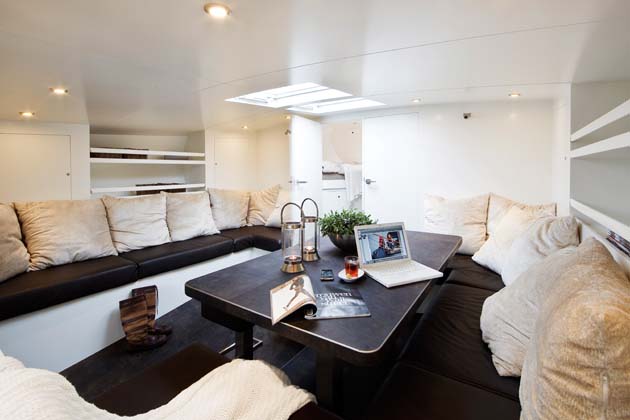
As a party boat Warber is hard to beat. There were 13 of us aboard for our sail, yet we were rattling around in the cockpit. And Blom’s party trick was to leave the berth in the centre of the town of Heeg, where he picked us up, utterly silently – 1,100kg of batteries and a hybrid engine sited beneath the cockpit provide five hours of motoring.
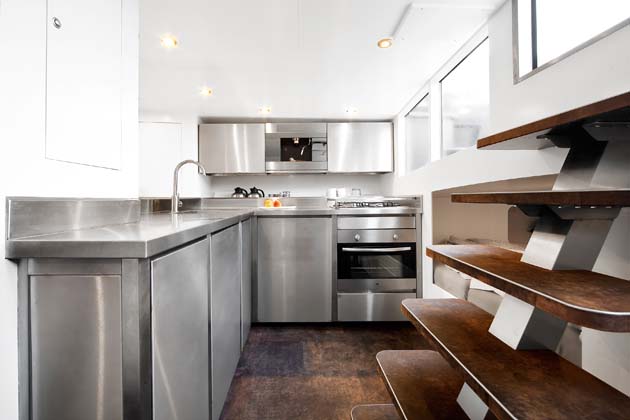
Sailing the Lemsteraak was eye-opening. It was a fine summer’s evening as we slid silently out onto the Heegermeer, a branch of the IJsselmeer. The extra hard-coated black Dacron sails, which felt as supple as cardboard, were hoisted, using a gaff and mast hoops for the main.
As we navigated the narrow channels I was pleasantly surprised to note that we were matching the single-figure wind speeds under spinnaker.
The 400kg leeward board is lowered into the water as pressure builds on the gargantuan tiller. Racing barges have completely flat bottoms and draw as little as 38cm – hence the requirement for hefty leeboards.
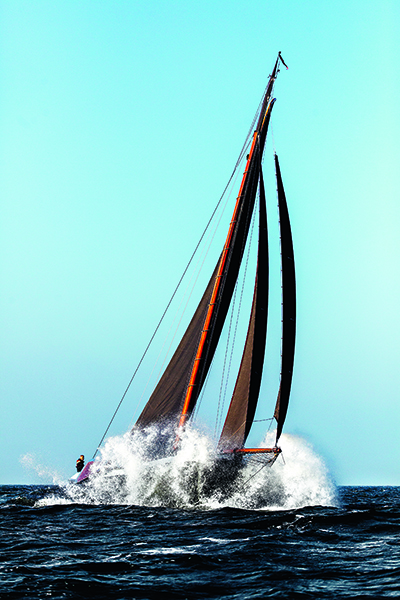
Once the jib and flying jib (kluiver) were set she really started slipping along – and heeling too when powered up. It’s a mesmerising experience within the confines of the flat inland waters.
Lemsteraaks race every other weekend, often completing three to six races per weekend. “It can be very competitive, with 33 on the line,” says Blom. And these leeboarders have surprising performance – Warber’s designers report that she can sail at 7.4 knots close-hauled at apparent wind angles equal to modern racing yachts.
A test conducted against an X40 found Warber to be comparable in speed. It was reported that she pointed just as high and went as fast, but lost out in manouevrability.
And there is surprisingly little leeway – her naval architect Niels Moerke reports that these boats “can generate much more side force than normal monohulls”.
CFD on a 19th Century design
Van Oossanen applied the most modern design methods to this hull shape for the first time – you may remember that Peter van Oossanen, the founder of the company, drew Australia II’s famous wing keel. Director Niels Moerke explains how, by using CFD, they could visualise the flow around the boat without needing a towing tank.

“We did 75 CFD runs on the hull, which is a bit insane – normally we’d run five to ten – but this is our passion,” says Moerke. The result was that 14 variations were made to her hull shape. “In the end were able to increase longitudinal stiffness by 15 per cent . . . and lower the pressure resistance up to 23 per cent without it costing us any viscous resistance.”
When we spoke to Van Oossanen last year, they had just launched a 44ft Lemsteraak and had two more designs in build, plus three 48-footers and one 52-footer in design.
“The reason they are so popular here is that they are very comfortable to sail with the family and very spacious. You can dry out and have a barbecue, etc – and you can race competitively too,” explains Niels Moerke.
Dimensions
LOA 15.50m/50ft 10in
LWL 13.94m/45ft 9in
Beam 5.60m/18ft 4in
Draught 1.00m/3ft 3in
Displacement 30,700kg/67,680lb
Sail area upwind 158.4m2/1,705ft2
downwind 255m2/2,745ft2
Price ex VAT €800,000 (£639,860)
DETAILS
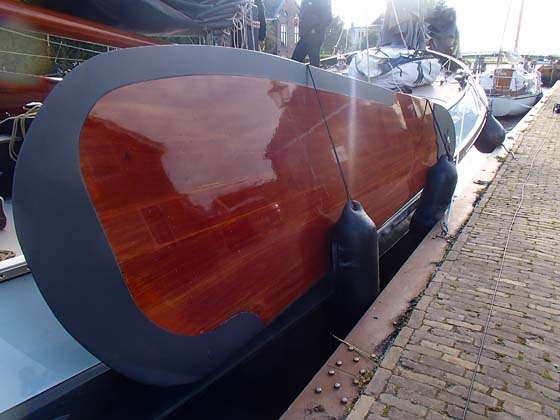
The leeboards are 3.5m long – but only 1.5m of that is immersed. “A lot of the competitive vessels have changed to asymmetric modern boards,” says Blom
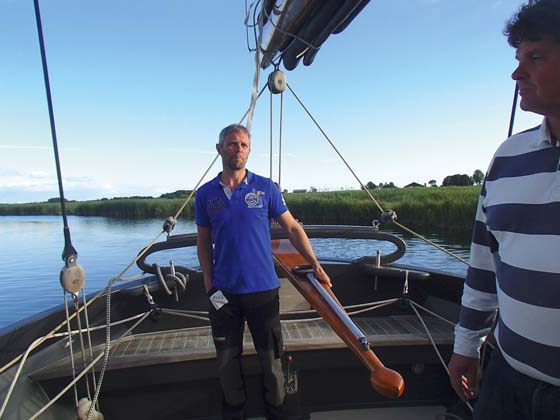
Warber’s owner, Dirk Blom, at the helm. Note the extension added to the lengthy wooden tiller so Blom can sit out and get clear visibility forward
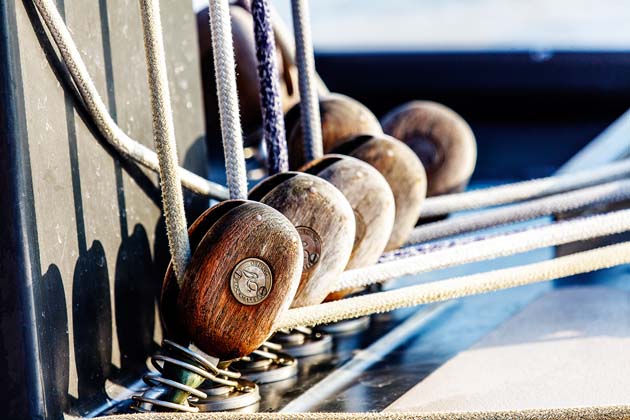
Traditional looks mask modern materials. A hydraulic pump is concealed below the deck-stepped mast, so the crew is able to crank on serious forestay tension
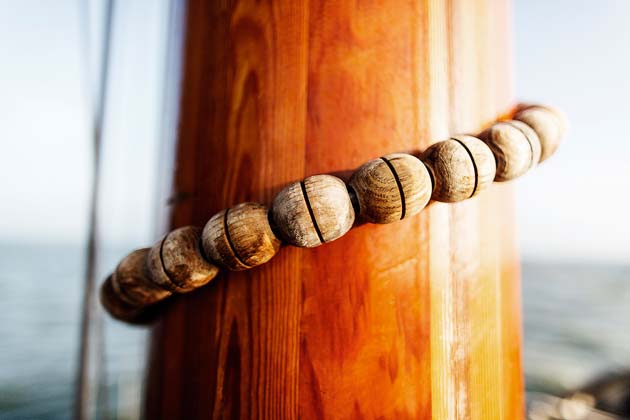
Dyneema running rigging and Aramid running backstays make for an unusual combination with traditional wood blocks and parrel bands

The modern Harken Radial winches are mounted at an angle – an idea owner Dirk Blom had to make them more comfortable to operate
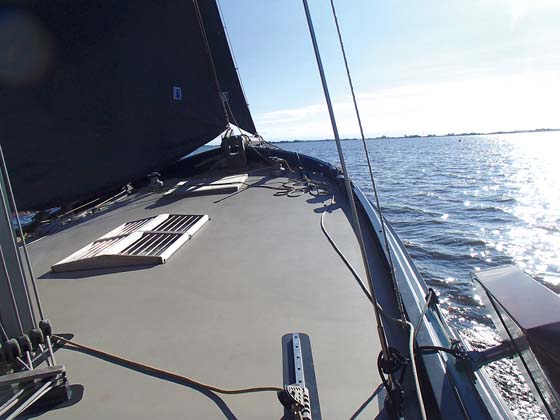
The foredeck hatch was added to satisfy the traditional aesthetic requirements of the class.
Wood was added around the windows for the same reason

Mast, leeboards and rudder have all to be made from wood, whereas the hull is always steel
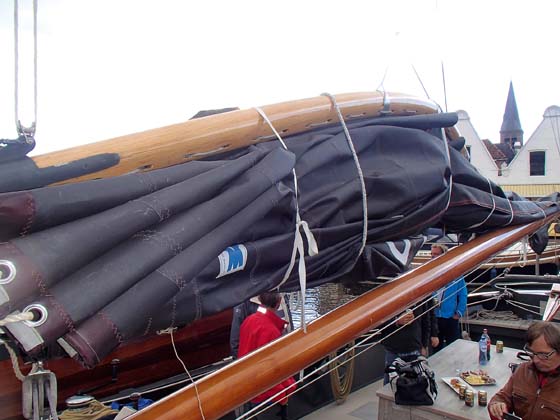
Lemsteraak builders were not able to make high masts so used a gaff – curved for aerodynamic purposes
Hal Sisk, Chairman Association of Yachting Historians and Captain of the Water Wags, writes:
“This boat type was not a fishing boat in the sense of a vessel catching fish. Instead it was developed as a seagoing fish carrier to transport fresh fish and mussels from the active fishing fleet to the markets as quickly as possible.
Thus from the beginning Lemsteraaks were built for speed. The rounded hull shape above the waterline belies an easily driven hull, while the tumblehome helps the leeboards to work vertically and rest more easily when hoisted.
Long before aircraft wings and CFD, Dutch sailors and builders of traditional craft developed by trial and error highly efficient deep leeboards, which were aerofoil in cross section, hollowed on the inboard side and convex outside, even ‘toed in’ by 4° to provide asymmetric lift. Truly sophisticated foils, quite unlike the flat leeboards of Thames Barges and Dutch inland waterways craft.
So even before the modern ‘pimping up’, Lemsteraaks were powerful fast sailing craft, far removed from the common outsiders’ description of such craft as ‘Dutch barges’.
Finally, the Dutch Foundation of ‘Ronde- en Platbodemjachten’ must be applauded for maintaining traditional vertical-cut sails, unlike the arms race in sail design and cut in other classic classes, which also often include inauthentic modern downwind sails for which the rigs were never designed.”




